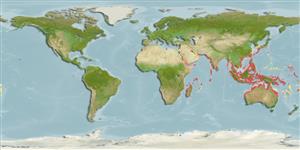Common names from other countries
Environment: milieu / climate zone / depth range / distribution range
Οικολογία
Θαλασσινό(ά); Υφάλμυρο βενθοπελαγικό. Tropical; 35°N - 37°S, 20°E - 178°W
Indo-Pacific: Persian Gulf to Fiji and north to Japan. Known from Delagoa Bay, Mozambique and Suez Canal on the African coast. Western Atlantic: introduced at Trinidad and Panama Canal near Atlantic end (Ref. 26938).
Μέγεθος / Βάρος / Age
Maturity: Lm ? range ? - ? cm
Max length : 9.5 cm SL αρσενικό/απροσδιόριστο; (Ref. 4404); μεγ. αναφερόμενη ηλικία: 4 έτη (Ref. 11441)
Ραχιαίες άκανθες (συνολικά) : 11 - 13; Μαλακές ραχιαίες ακτίνες (συνολικά) : 19 - 24; Εδρικές άκανθες: 2; Μαλακές εδρικές ακτίνες: 20 - 26. Head without cirri and crest. Lower end of gill opening opposite upper margin of pectoral fin. Sensory pores in infraorbital and interorbital canals mostly 8 and 3 respectively. Lateral line usually 7 to 11. Horizontal stripes on body distinct in male, but somewhat obscure in female.
Adults occur in coastal and brackish waters among rocks and mangroves (Ref. 9710). Oviparous. Eggs are demersal and adhesive (Ref. 205), and are attached to the substrate via a filamentous, adhesive pad or pedestal (Ref. 94114). Larvae are planktonic, often found in shallow, coastal waters (Ref. 94114). Highly tolerant to adverse environmental conditions, self-reproducing population living between rocks in natural oil seeps in Venezuela (Ref. 56126).
Life cycle and mating behavior
Maturities | Αναπαραγωγή | Spawnings | Egg(s) | Fecundities | Προνύμφες
Oviparous, distinct pairing (Ref. 205).
Springer, V.G., 1986. Blenniidae. p. 742-755. In M.M. Smith and P.C. Heemstra (eds.) Smiths' sea fishes. Springer-Verlag, Berlin. (Ref. 4404)
IUCN Red List Status (Ref. 130435)
CITES (Ref. 128078)
Not Evaluated
Threat to humans
Harmless
Human uses
αλιεία: χωρίς ενδιαφέρον
Εργαλεία
Special reports
Download XML
Διαδικτυακές πηγές
Estimates based on models
Preferred temperature (Ref.
115969): 24.7 - 29.1, mean 28.4 (based on 2724 cells).
Phylogenetic diversity index (Ref.
82804): PD
50 = 0.5000 [Uniqueness, from 0.5 = low to 2.0 = high].
Bayesian length-weight: a=0.00741 (0.00410 - 0.01339), b=3.09 (2.92 - 3.26), in cm Total Length, based on LWR estimates for this species & (Sub)family-body (Ref.
93245).
Τροφικό Επίπεδο (Ref.
69278): 2.5 ±0.1 se; based on size and trophs of closest relatives
Ελαστικότητα (Ref.
120179): Μεσαίο(α), ελάχιστος χρόνος για διπλασιασμό πληθυσμού 1,4 - 4,4 έτη (tmax=4).
Fishing Vulnerability (Ref.
59153): Low vulnerability (10 of 100).
